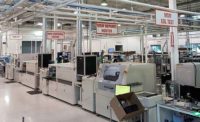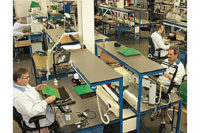Among the largest purchasers of Vicor Corp.’s power components and systems are electronic manufacturers for the U.S. military. These products use printed circuit boards (PCBs) and always meet MIL performance specs. Founded in 1981, the company currently manufactures its products using highly automated processes in several facilities, which are ISO 9001-registered.
In early 2011, Vicor Corp. researched ways to improve stencil yields on the company’s PCB panels, also called multiblocks. Each board has a unique stencil, through which solder is pushed via a squeegee to indicate where components will be located.
PCB panels are often used to increase manufacturing capacity. They consist of many smaller individual PCBs that will be used in the final product. The panels are depaneled at some stage in the manufacturing process.
Ray Whittier, senior process engineer at Vicor Corp., looked into using coatings to improve yield. Eventually he attended a webinar hosted by DEK International discussing its Nano-ProTek coating.
Nano-ProTek is a two-part, wipe-on coating that renders the underside of the stencil fluxophobic, preventing flux and the integrated metal solder paste particles from leaching into the stencil web. The coating applies easily to new or existing stainless steel and nickel stencils.
“There’s always room for process improvement,” says Whittier. “I decided to try the stencil coating on a very challeng-ing product we were producing to find out if it would yield any benefit for us. I was pleasantly surprised.”
Vicor applied the coating to numerous PCB panels, each of which housed nearly 200 components (0402, 0201, BGA and micro-BGA) and had a circuit size of less than 1 inch wide by 1.25 inches long. The panel requires a 501-aperture-count stencil, which was printed using a DEK Horizon 01i platform.
The Horizon 01i platform has an 8-second cycle time and handles PCBs up to 508 millimeters square.
Stencils coated with Nano-ProTek were compared with non-coated stencils. Whittier says the coated stencils increase transfer efficiency and significantly improve first pass yields and process capability. It also improves cleaning effectiveness and reduces cleaning frequency.
“When you consider operator and line stoppage costs, the savings we are realizing are considerable,” says Whittier. “For a per stencil cost of less than $50, I think it’s a pretty darn good return on investment.”
Nano-ProTek can be used to coat stencils up to 29 by 29 inches.
Environmentally friendly, the coating can be applied in less than 5 minutes and reapplied at any time. It complies with the Registration, Evaluation,
Authorization and Restriction of Chemicals (REACH) regulation of the European Union.
For more information on stencil coatings and PCB printing platforms, call 901-797-9368 or visit www.dek.com.
Nano Coating Yields Better PCB Panels

Nano-ProTek is a two-part, wipe-on coating that renders the underside of the PCB stencil fluxophobic, preventing flux and the integrated metal solder paste particles from leaching into the stencil web. Photo courtesy DEK International


